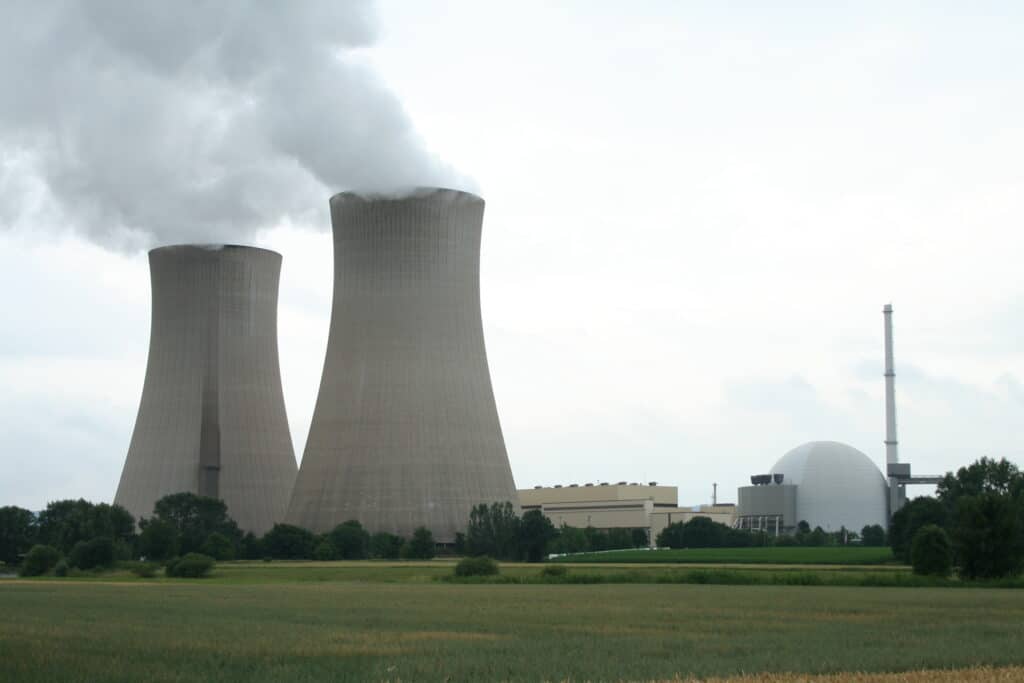Germany closed its last three nuclear reactors in April after years of struggles. While it is true that wind and solar energy have grown over time, the country still heavily relies on coal and gas. A nuclear phase-out may now risk increasing Germany’s reliance on fossil fuels.
—
On April 15th, Germany became the second major economy to ditch nuclear energy for good, after Italy did the same in 1990.
In the wake of the shutdown of its last three reactors – Isar 2, Emsland, and Neckarwestheim 2 – Germany enters a new, uncertain era. Far from being part of a recent phenomenon, this choice represents the culmination of decades of efforts by activists, opposing parties, and even competing governments.
Nuclear scepticism is nothing new in Germany, as it is throughout the West. And like other European and North American movements, Germany’s anti-nuclearism dates back to the 1970s. However, the anti-nuclear sentiment truly gained traction in the early eighties during heightened tensions between the East and the West.
In 1979, the US pledged to provide Pershing II missiles to West Germany in response to the deployment of the new Soviet-made SS-20 medium-range missiles. Fear of nuclear escalation began to spread again among the German public, especially concerning the effects of radiation on human health. As the ominous spectre of nuclear annihilation haunted German civil society, part of that fear also began to reflect on how the public perceived atomic energy itself.
Although bombs and reactors operate widely different technologies, the connection was always present in public discourse and became even more relevant after the Chornobyl incident of 1986.
In the wake of the disaster – a true embodiment of the failures of Soviet bureaucracy – it seemed as if the anti-nuclear movement’s claims had been validated. And in some ways, the incident was probably enough to decouple the fear of nuclear technology from the more general paranoia of mutually assured destruction. In the eyes of the German public, it became its own thing, surviving even the end of the Cold War.
In the meantime, as activists marched proudly wearing the “Atomkraft? Nein Danke” (“Nuclear energy? No thank you”) badge, new political organizations emerged, some even making it to the German Bundestag (the national Parliament). One of them was the Green Party, founded in 1980 by a coalition of leftists, pacifists, environmentalists, and anti-nuclear activists. It was elected to the Parliament for the first time in 1983 and steadily gained popularity over the next few decades.
In the 1990s, with the iron curtain dismantled, the discussion expanded to nuclear waste. Attempts by the government to establish a final storage site and build a reprocessing plant were met with strong opposition, not just from the public but also from local officials. In 1995, a temporary nuclear waste disposal site was planned in Gorleben, a small town located in Lower Saxony. Gorleben was never intended to be the final deposit for leftover materials. Yet, in a matter of weeks, the town became a symbol of the struggle against state-imposed nuclear waste facilities.
During that time, the protests were supported by Lower Saxony’s then-Minister-President Gerhard Schröder. In 1998, Schröder became Chancellor of Germany, presiding over a coalition of Social Democrats (SPD) and the Green Party. The coalition proposed to phase out nuclear power plants in the coming years, theoretically closing the last one by 2022. However, the Christian Democratic Union (CDU) and its chairwoman, Angela Merkel, disapproved of the decision and vowed to reverse it if they won the 2005 elections.
After Merkel became Chancellor, the government revoked the deal, extending the lives of all nuclear power plants still in operation. Merkel, a scientist with a PhD in physics, was an anomaly in German politics. Before taking office, she was Minister for Environment and Nuclear Safety from 1994 to 1998. During that time, she stood up to the protesters during the Gorleben crisis, stating that the issue had to be handled technocratically.
The situation changed in 2011 after the Fukushima nuclear accident. In response to the growing popularity of the Green Party, Chancellor Merkel unexpectedly reversed her decision, resuming the plan of her predecessor to close the remaining power plants by 2022.
Then, in February 2022, Russia invaded Ukraine.
In the wake of the resulting hydrocarbon crisis triggered by Moscow, keeping the remaining nuclear power plant appeared to be the most reasonable solution. The Social Democrats and the Green Party were in power again, yet a compromise seemed at hand – if anything, for sheer pragmatism. Nevertheless, after a brief delay justified by winter, the last three reactors were permanently shut down in April 2023.
You might also like: The Nuclear Waste Disposal Dilemma
Now, the country that prided itself on championing renewable energy is solving its energy woes through something as environmentally unfriendly as coal. With hindsight, these choices seem even harder to justify. The Social Democrats and the Green Party in the 1990s and early 2000s may have targeted this resource instead of nuclear. However, while coal mining only accounted for a small portion of all jobs in Germany, many were located in Social Democrats’ strongholds.
So, Schröder’s idea in 1998 was to reach an agreement with the Green Party: Closing the nuclear power plant, a symbol for those raised in the wake of Chornobyl, scaling up renewables, and hope for the best.
The same applies to Merkel in 2011. The choice was once again political, to get voters away from the Green Party, which was experiencing a sharp rise in popularity. Similarly, the solution had the same amount of wishful thinking – acquiring most fossil fuels from a notoriously undemocratic and mercurial country with territorial ambitions toward its neighbours.
In twenty years’ time, wind and solar indeed have grown in capacity, going from 16 TWh in 2002 to 185 TWh in 2022. At the same time, nuclear energy went from generating 165 TWh of electricity to only 35. Coal use decreased as well, although not as much, from 293 TWh to 183, while gas grew slightly, from 56 to 77 TWh.
But there’s a catch. Solar and wind are highly intermittent, only working best on sunny or windy days. In addition, there is no way yet to effectively store energy when these resources are at full capacity, which brings us to the real issue of the debate about nuclear power. For renewables to work best, they must be supported by reliable sources that function consistently every moment. And with nuclear out of the picture, coal becomes once again the best candidate to power the country.
So, while wind and solar have absorbed most of the decrease in nuclear energy production and coal has declined by over one-third, the latter remains equal to renewables in terms of power generation. And with the closure of the last three reactors, only a handful of that demand will now be replaced by low-carbon resources. A day after the shutdown, coal – but also nuclear power from France – immediately replaced most of the energy needed.
The environment and European Union climate goals are the most prominent victims of this choice, but also consumers and local industries. By ditching a cheap power source, energy costs will rise even more, making companies less competitive and putting an unnecessary burden on families.
According to a paper published in 2022 in the Journal of the European Economic Association by Stephen Jarvis, Oliver Deschenes, and Akshaya Jha, the nuclear power phase-out has already cost Germany between €3 and 8 billion euros per year.
This choice makes little sense even as a trade-off based on health risks. As scary as it was, the Fukushima incident did not result in deaths by radiation poisoning, nor did the area around the power plant become an exclusion zone, as it happened in Ukraine. Chornobyl was the only true nuclear power-related tragedy. Yet, the four thousand excess death estimated in Ukraine, Belarus, and Russia between 1986 and 2006 pale compared to fossil fuels’ excessive yearly deaths.
According to a peer-reviewed paper published by climate scientists Pushker A. Kharecha and Makiko Sato from Columbia University in 2019, significant emissions and fatalities would have been avoided if coal and gas were closed instead of nuclear power. Specifically, Germany could have prevented up to 4.6 thousand deaths between 2011 and 2017, all by pairing atomic energy with renewables and phasing out fossil fuels.
Regardless of how one perceives nuclear energy, all of this matters, as every pressing issue of our time is linked to energy. The type of energy we use impacts our capacity to counter the most dreadful effects of climate change. Energy costs significantly influence a country’s prosperity and economic inequality since they affect families and businesses. And, of course, energy imports from unstable countries are a further security issue—not just for Germany, as the Ukrainians have experienced.
No technology is completely risk-free, including nuclear. However, the latter emits virtually no CO2, unlike natural gas, oil, and coal. Additionally, unlike wind and solar, it does not depend on atmospheric conditions, so it is as reliable as fossil fuels and as low-carbon as classic renewables. Nevertheless, as with most things, in the end, it’s just a matter of choice – albeit one that may also have implications for the rest of the EU.
Featured image: Wikimedia Commons.
You might also like: The Advantages and Disadvantages of Nuclear Energy


















